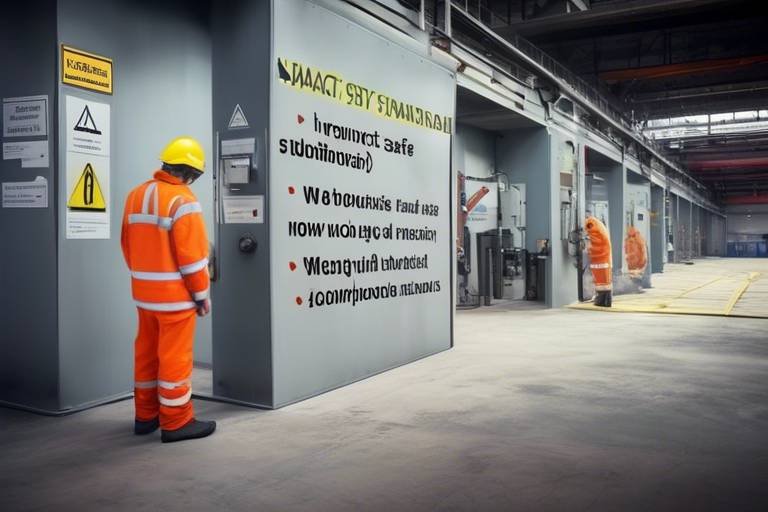A Study on Human Behavior and Safety Measures
This article explores the intricate relationship between human behavior and safety protocols, examining how psychological factors influence safety measures and the effectiveness of various strategies in promoting safer environments. Safety isn’t just about rules and regulations; it’s about understanding the people behind those rules. When we dive deep into the psychology of human behavior, we find that our actions, perceptions, and emotions play a significant role in how we approach safety in our daily lives.
Human behavior significantly impacts safety outcomes. To truly grasp the effectiveness of safety measures, we must first delve into the psychological aspects that drive individuals' actions. For instance, consider how someone reacts when they see a warning sign. Do they merely acknowledge it, or do they change their behavior accordingly? Understanding these behaviors is crucial in developing effective safety measures. It’s like trying to solve a puzzle; each piece represents a different aspect of human psychology, from motivation to perception, and only when they fit together can we create a comprehensive safety strategy.
Perception plays a crucial role in how individuals assess risk. Imagine walking through a construction site; the sound of machinery and the sight of hard hats might make you more aware of potential dangers. However, if someone has never experienced a safety incident, they might underestimate the risks involved. This section discusses how people's perceptions of danger influence their behavior and decision-making in safety-related situations. It’s fascinating how a person's background, experiences, and even cultural influences can shape their perception of safety. Are they more cautious because of a past incident, or do they feel invincible, believing that accidents only happen to others?
Cognitive biases can lead to flawed safety decisions. These mental shortcuts can distort our judgment and lead us to make choices that compromise safety. For example, the overconfidence bias can cause individuals to underestimate risks, believing they are less likely to be harmed than others. This phenomenon is particularly dangerous in high-risk environments, where a single miscalculation can have dire consequences. Here, we explore common biases that affect judgment and how they can compromise safety measures in various environments.
Overconfidence can lead individuals to underestimate risks. Think about a seasoned driver who has never been in an accident. This person might believe they can text while driving without consequences, ignoring the very real dangers associated with distracted driving. This subsection examines how overconfidence impacts safety behaviors and the importance of fostering a realistic understanding of risks. By acknowledging our limitations and the unpredictability of life, we can cultivate a more cautious approach to safety.
The availability heuristic affects how people perceive risk based on recent experiences. If someone has recently heard about a workplace accident, they may become overly cautious or anxious about similar situations, even if the actual risk hasn't changed. This part discusses how this mental shortcut can skew safety assessments and lead to dangerous outcomes. It’s a classic case of letting emotions dictate decisions rather than relying on facts and statistics.
Emotions significantly influence behavior in safety contexts. Fear, anxiety, and stress can cloud judgment and lead to poor decision-making. For instance, in a high-pressure situation, an employee might forget to follow safety protocols due to panic. This section discusses how these emotional responses can affect adherence to safety protocols. Understanding the emotional landscape of employees can help organizations implement strategies that not only address safety measures but also support mental well-being.
A strong safety culture is essential for effective safety measures. It’s not just about having protocols in place; it’s about creating an environment where safety is prioritized and valued. This section explores how organizational values, beliefs, and practices shape employee behavior and commitment to safety. When employees feel that their safety is genuinely cared for, they are more likely to adhere to safety measures and report unsafe conditions.
Leadership plays a pivotal role in establishing a safety culture. Leaders set the tone for safety practices through their actions and communication. If leaders prioritize safety, employees are more likely to follow suit. This subsection discusses how leaders can influence safety behaviors through communication, accountability, and support. It’s essential for leaders to model safe behaviors and reinforce the importance of safety in all aspects of the organization.
Engaging employees in safety practices enhances compliance and awareness. When employees feel involved in safety initiatives, they are more likely to take ownership of their safety and that of their colleagues. This part examines strategies for fostering employee involvement in safety initiatives and the benefits of a participatory approach. By creating a culture of collaboration, organizations can ensure that safety measures are not just rules but a shared commitment to well-being.
- What is the importance of understanding human behavior in safety measures?
Understanding human behavior helps in designing effective safety protocols that resonate with individuals' perceptions and emotional responses. - How do cognitive biases affect safety decisions?
Cognitive biases can lead to flawed judgments and decision-making, often resulting in unsafe practices. - What role does leadership play in promoting safety culture?
Leadership sets the tone for safety practices, influencing employee behavior and commitment to safety through communication and accountability. - How can organizations engage employees in safety practices?
Organizations can foster engagement by involving employees in safety initiatives and encouraging feedback and participation.

[Understanding Human Behavior]
When it comes to safety, understanding human behavior is like holding the key to a treasure chest. Imagine trying to unlock a door without knowing the combination; that's what it feels like when safety measures are implemented without considering how people think and act. Our behaviors are influenced by a myriad of factors, including our experiences, emotions, and even our environment. This intricate web of influences shapes how we respond to safety protocols. For instance, if someone has previously experienced a safety incident, their subsequent reactions may be colored by fear or anxiety, which can either lead to heightened caution or reckless behavior.
The psychological aspects of human behavior are vital for developing effective safety measures. When organizations recognize that their employees are not just robots following instructions but rather complex individuals with emotions and biases, they can tailor their safety strategies to resonate more deeply. This understanding fosters a culture where safety is not just a set of rules but a shared value. For example, a workplace that encourages open discussions about safety concerns allows employees to voice their fears, leading to a more comprehensive understanding of potential risks.
Furthermore, the context in which safety measures are applied plays a crucial role in shaping behavior. Consider a construction site where safety helmets are mandatory. If workers see their peers consistently wearing helmets, they are more likely to adopt the same behavior. Conversely, if they observe others neglecting this safety measure without consequence, they may feel emboldened to do the same. This highlights the importance of not just implementing safety protocols but also ensuring they are visibly adhered to by everyone in the organization.
To truly grasp the nuances of human behavior in safety contexts, we can break it down into several key components:
- Motivation: Understanding what motivates individuals to follow safety protocols can lead to more effective strategies. Is it fear of punishment, desire for safety, or a sense of responsibility?
- Social Influence: People are social creatures. The behavior of peers can significantly impact individual choices, making it essential to cultivate a community that prioritizes safety.
- Communication: Clear and open communication regarding safety measures can help bridge the gap between policy and practice. When employees understand the "why" behind safety rules, they are more likely to follow them.
In conclusion, understanding human behavior is not just an academic exercise; it is a practical necessity for fostering a safe environment. By acknowledging the psychological factors at play, organizations can devise strategies that not only promote compliance but also cultivate a culture of safety that resonates with every individual. This, in turn, leads to a more secure and productive workplace, where safety is a shared responsibility rather than a mere obligation.

[The Role of Perception in Safety]
Perception is a powerful force that shapes our understanding of the world around us. When it comes to safety, the way individuals perceive risks can significantly influence their behavior and decision-making. Imagine walking through a construction site; if you see workers wearing hard hats and safety vests, your perception of the environment might shift from one of danger to one of safety, simply because of those visible safety measures. This highlights how perception can create a sense of security or alarm, depending on the cues present.
People often assess risks based on their past experiences, cultural background, and even the media they consume. For instance, if someone has recently heard about a workplace accident, they might become overly cautious in similar environments, perhaps even to the point of being paralyzed by fear. Conversely, someone who has never experienced or heard of an incident may underestimate potential dangers. This discrepancy in perception can lead to vastly different safety behaviors among individuals, which is why understanding these perceptions is crucial for developing effective safety protocols.
A fascinating aspect of perception is its subjective nature; what feels safe to one person may seem risky to another. This subjectivity can be attributed to various factors, including personal experiences, cognitive biases, and emotional states. For instance, a person who has experienced a minor injury in a specific context may perceive that situation as hazardous, while someone else, who has never encountered such an event, may view it as benign. Consequently, safety measures must be tailored to account for these diverse perceptions.
To illustrate this point, consider a workplace where employees are required to wear safety goggles. Some workers may perceive this requirement as an unnecessary hassle, while others may see it as a vital precaution. This difference in perception can affect compliance and adherence to safety protocols. Therefore, it becomes essential for organizations to not only enforce safety measures but also to communicate their importance effectively. By fostering an environment where employees understand the rationale behind safety protocols, organizations can bridge the gap between perception and reality.
Moreover, perception is closely tied to the concept of **risk communication**. Clear and effective communication can help shape how individuals perceive risks. When safety messages are conveyed in a relatable and engaging manner, they are more likely to resonate with employees. For example, using real-life stories or statistics about workplace incidents can enhance awareness and understanding, leading to improved safety behaviors.
In summary, perception plays a crucial role in safety. It influences how individuals assess risks, make decisions, and ultimately behave in potentially hazardous situations. By understanding the psychological aspects of perception, organizations can create more effective safety measures that resonate with their employees, fostering a culture of safety that is proactive rather than reactive. After all, when individuals feel safe and understand the reasons behind safety protocols, they are more likely to embrace them wholeheartedly.
- How can organizations improve employees' perception of safety?
Organizations can improve safety perception by providing training, sharing real-life safety incidents, and encouraging open communication about safety concerns.
- What role does emotional intelligence play in safety perception?
Emotional intelligence helps individuals recognize and manage their emotions and the emotions of others, which can lead to better understanding and adherence to safety protocols.
- Can perception be changed over time?
Yes, perception can evolve with new experiences, information, and changes in the environment. Continuous education and engagement can help shift perceptions towards a more safety-conscious mindset.

[Cognitive Biases and Safety Decisions]
Cognitive biases are the mental shortcuts our brains take that can lead to irrational decisions, especially in safety contexts. These biases affect how we perceive risks and make judgments about safety measures. For instance, when individuals are faced with a potential danger, their cognitive biases can cloud their judgment, leading them to either overestimate or underestimate the risks involved. Understanding these biases is crucial for developing effective safety protocols that can mitigate their negative impacts.
One common cognitive bias is the **overconfidence bias**, where individuals believe they are less likely to experience negative outcomes than others. Imagine someone who regularly drives without a seatbelt, convinced that they are skilled enough to avoid accidents. This overconfidence can lead to dangerous behaviors, as the individual underestimates the likelihood of an accident occurring, thus compromising their safety. Studies have shown that fostering a more realistic understanding of risks can help counteract this bias, encouraging safer behaviors.
Another significant bias is the **availability heuristic**, which causes people to judge the probability of events based on how easily examples come to mind. For instance, if someone recently heard about a plane crash, they might irrationally conclude that flying is far more dangerous than it actually is. This mental shortcut can skew their perception of risk and lead to poor safety decisions, such as avoiding air travel altogether while ignoring the much higher risks associated with driving. By recognizing how recent experiences influence their perceptions, individuals can make more informed decisions regarding safety.
These cognitive biases not only affect individual behavior but can also permeate organizational culture. For example, if a company has experienced a few minor accidents without severe consequences, employees might develop a sense of complacency, believing that "it won't happen to me." This collective overconfidence can lead to a decline in adherence to safety protocols, increasing the likelihood of serious incidents. Organizations must actively work to address these biases by implementing training programs that highlight the importance of risk assessment and the potential consequences of overconfidence and flawed perceptions.
In summary, cognitive biases significantly influence safety decisions, leading to behaviors that can compromise safety protocols. By understanding these biases, both individuals and organizations can take proactive steps to foster a culture of safety that prioritizes realistic risk assessments and encourages adherence to safety measures. This understanding not only enhances personal safety but also contributes to a safer environment for everyone involved.
- What are cognitive biases? Cognitive biases are systematic patterns of deviation from norm or rationality in judgment, which can affect decision-making in various contexts, including safety.
- How does overconfidence bias affect safety decisions? Overconfidence bias leads individuals to underestimate risks, potentially resulting in dangerous behaviors and a lack of adherence to safety protocols.
- What is the availability heuristic? The availability heuristic is a mental shortcut that relies on immediate examples that come to mind when evaluating a specific topic, concept, method, or decision, often skewing risk perception.
- How can organizations address cognitive biases? Organizations can address cognitive biases by implementing training programs that emphasize realistic risk assessments and encourage open discussions about safety practices.

[Overconfidence Bias]
Overconfidence bias is a fascinating psychological phenomenon where individuals overestimate their abilities, knowledge, or control over situations. Imagine a tightrope walker confidently striding across a high wire, believing they can easily make it to the other side without any safety harness. This scenario mirrors how many people approach safety in various environments, from workplaces to everyday life. They often think, "I know what I’m doing; I’ve done this a thousand times," which can lead to risky behaviors and a disregard for safety protocols.
This bias can be particularly dangerous because it creates a false sense of security. For instance, in a workplace setting, an employee might skip wearing protective gear, convinced that they can handle machinery without any risk of injury. Such overconfidence can compromise not only their safety but also the safety of their colleagues. The reality is that accidents can happen to anyone, regardless of experience level. To illustrate this point, consider the following table that highlights the potential consequences of overconfidence in different scenarios:
| Scenario | Overconfidence Behavior | Potential Consequences |
|---|---|---|
| Construction Site | Skipping safety gear | Injury or fatality |
| Driving | Exceeding speed limits | Accident or legal penalties |
| Laboratory | Ignoring safety protocols | Exposure to hazardous materials |
As you can see, the repercussions of overconfidence can be severe. It’s essential to recognize that while confidence can be beneficial, it should be balanced with a realistic assessment of risks. One effective strategy to combat overconfidence bias is to foster a culture of humility and awareness. Encouraging individuals to acknowledge their limitations and to seek feedback can create a safer environment.
Moreover, training sessions that emphasize real-life scenarios and potential risks can help individuals recalibrate their perceptions. Engaging in discussions about past incidents and analyzing how overconfidence played a role can also be enlightening. This approach not only educates but also cultivates a mindset that values safety over bravado. In essence, understanding and addressing overconfidence bias is crucial for enhancing safety measures and ensuring that individuals make informed decisions that prioritize their well-being and that of others.
- What is overconfidence bias?
Overconfidence bias is the tendency to overestimate one's abilities, knowledge, or control over situations, often leading to risky behaviors.
- How does overconfidence affect safety?
It can lead individuals to underestimate risks and ignore safety protocols, increasing the likelihood of accidents and injuries.
- What can organizations do to mitigate overconfidence bias?
Organizations can foster a culture of humility, provide training on risk assessment, and encourage open discussions about safety practices.

[Availability Heuristic]
The availability heuristic is a powerful mental shortcut that influences how we perceive risk and make decisions. Essentially, it leads us to judge the likelihood of an event based on how easily we can recall similar instances from our memory. For example, if someone recently heard about a plane crash, they might overestimate the dangers of flying, even though statistically, air travel is one of the safest modes of transportation. This phenomenon can significantly skew our understanding of risk in safety contexts.
When individuals rely on the availability heuristic, they tend to focus on vivid, memorable events rather than the actual probabilities. This can lead to a distorted view of reality, where people react more strongly to recent news stories or personal experiences rather than considering comprehensive data and statistics. Imagine a person who lives in an area prone to wildfires. If they hear about a wildfire on the news, their fear may escalate, prompting them to take excessive precautions. However, if they fail to consider the overall frequency of such events in their area, they may be overreacting.
This mental shortcut can have profound implications for safety measures in various environments, including workplaces, public spaces, and even at home. Organizations must recognize that employees might be influenced by their recent experiences or media portrayals rather than an objective assessment of risks. To mitigate the effects of the availability heuristic, it’s essential to provide comprehensive training and resources that highlight statistical data and emphasize a broader understanding of safety protocols.
To illustrate this point further, consider the following table that compares common perceptions of risk with actual statistical data:
| Event | Perceived Risk | Actual Risk |
|---|---|---|
| Plane Crash | High | 1 in 11 million |
| Car Accident | Moderate | 1 in 5,000 |
| Shark Attack | Very High | 1 in 3.7 million |
| Heart Disease | Low | 1 in 5 |
This table highlights the disparity between perceived and actual risks, showcasing how the availability heuristic can lead to irrational fears and safety practices. By addressing these misconceptions and focusing on factual information, organizations can foster a more informed approach to safety that prioritizes adherence to protocols based on objective data rather than emotional reactions.
In conclusion, the availability heuristic serves as a reminder of the complexities of human behavior in safety contexts. Understanding this cognitive bias is crucial for developing effective safety measures that not only inform but also engage individuals in a meaningful way. By promoting awareness and education, we can help individuals make better decisions that align with actual risks, ultimately leading to safer environments for everyone.
- What is the availability heuristic? The availability heuristic is a mental shortcut that relies on immediate examples that come to mind when evaluating a specific topic, concept, method, or decision.
- How does the availability heuristic affect safety decisions? It can lead individuals to overestimate risks based on recent events or vivid memories, rather than relying on statistical data.
- What can organizations do to mitigate the effects of the availability heuristic? Providing comprehensive training and resources that highlight statistical data and emphasize a broader understanding of safety protocols can help.
- Why is understanding cognitive biases important for safety? Recognizing cognitive biases like the availability heuristic allows organizations to create more effective safety measures and training programs.

[Emotional Influences on Behavior]
When it comes to safety, emotions can act like a double-edged sword. On one hand, they can motivate individuals to adhere to safety protocols, while on the other, they can cloud judgment and lead to reckless behavior. Understanding the emotional influences on human behavior is crucial for developing effective safety measures. Let’s dive into how feelings like fear, anxiety, and stress can shape our decisions in safety-related situations.
For instance, fear is a powerful motivator. It can push people to take precautions they might otherwise ignore. Imagine walking on a slippery sidewalk. If you’ve seen someone fall there before, that fear can trigger a cautious approach, making you more aware of your surroundings. However, fear can also be paralyzing. In high-stress situations, individuals may freeze instead of taking appropriate action, which can lead to dangerous outcomes. This paradox illustrates how emotional responses can significantly impact safety behaviors.
Moreover, anxiety often plays a role in how people react to potential dangers. When faced with a perceived threat, anxiety can heighten awareness, prompting individuals to follow safety guidelines more closely. However, excessive anxiety can lead to avoidance behaviors, where individuals may choose to ignore safety measures altogether. For example, someone who is overly anxious about driving may avoid getting behind the wheel, but in doing so, they miss out on necessary experiences that could help them become a safer driver.
Stress is another emotional factor that can influence safety behavior. High-stress environments, such as construction sites or emergency response scenarios, can lead to mistakes if individuals are overwhelmed. Stress can impair cognitive functions, making it harder to concentrate on safety protocols. Therefore, it’s essential to create an environment where stress is managed effectively, allowing individuals to perform at their best.
To illustrate the interplay of these emotions in safety contexts, consider the following table that summarizes the emotional influences on behavior:
| Emotion | Positive Influence on Safety | Negative Influence on Safety |
|---|---|---|
| Fear | Increases caution and adherence to safety protocols | Can lead to freezing or panic in dangerous situations |
| Anxiety | Heightens awareness of potential risks | May cause avoidance of necessary safety measures |
| Stress | Encourages focus in manageable situations | Impairment of cognitive functions leading to mistakes |
In summary, while emotions can significantly influence safety behaviors, it’s important to understand their dual nature. Organizations and safety programs need to consider these emotional factors when designing training and safety protocols. By fostering an environment that addresses fear, anxiety, and stress, we can enhance safety compliance and create a culture of safety that is resilient in the face of emotional challenges.
- How can organizations manage employee anxiety related to safety?
Organizations can offer training programs that educate employees on risk management and stress reduction techniques. Providing a supportive environment where employees feel comfortable discussing their fears can also be beneficial. - What role does emotional intelligence play in safety practices?
Emotional intelligence helps individuals recognize and manage their emotions, leading to better decision-making in safety-critical situations. Training in emotional intelligence can enhance team dynamics and improve overall safety outcomes. - Can fear ever be counterproductive in safety contexts?
Yes, while fear can motivate caution, excessive fear can lead to paralysis or avoidance behaviors, which may compromise safety. It’s essential to strike a balance in addressing fear without allowing it to overwhelm individuals.

[Safety Culture in Organizations]
A strong safety culture is not just a buzzword; it's a fundamental aspect of any organization that prioritizes the well-being of its employees. Think of it as the backbone of a safe workplace. When safety becomes a shared value, it transforms how everyone interacts with safety protocols and practices. But what does a robust safety culture actually look like? It’s characterized by open communication, accountability, and a collective commitment to safety at all levels of the organization.
At the heart of a strong safety culture is the belief that everyone is responsible for safety, not just the management or safety officers. This collective mindset fosters an environment where employees feel empowered to speak up about potential hazards without fear of reprisal. Imagine a workplace where employees are not just following rules but are actively involved in shaping safety policies. This engagement leads to a more informed workforce that understands the importance of safety measures and adheres to them out of genuine concern for themselves and their colleagues.
Leadership plays a pivotal role in establishing and nurturing this culture. Leaders set the tone for safety practices by modeling appropriate behaviors and communicating the importance of safety consistently. For instance, when leaders participate in safety training and openly discuss safety issues, they demonstrate that safety is not just a priority, but a core value of the organization. This approach encourages employees to take safety seriously and to adopt similar attitudes in their daily tasks.
Moreover, organizations can enhance their safety culture by implementing various strategies that promote employee engagement. Here are a few effective methods:
- Regular Training: Ongoing training sessions keep safety at the forefront of employees' minds.
- Feedback Mechanisms: Encouraging feedback on safety practices allows employees to voice their concerns and suggestions.
- Recognition Programs: Recognizing employees who demonstrate exceptional safety practices can motivate others to follow suit.
In addition to these strategies, it’s essential to measure the effectiveness of safety culture initiatives. Organizations can use tools like surveys and incident reports to assess the current state of their safety culture. By analyzing this data, they can identify areas for improvement and make informed decisions about future safety initiatives.
Ultimately, a strong safety culture leads to numerous benefits, including reduced accidents, improved employee morale, and enhanced organizational reputation. When employees feel safe, they are more likely to be productive and engaged. In a world where workplace safety is paramount, organizations that prioritize safety culture are not just protecting their employees; they are also paving the way for long-term success.
Q: What is a safety culture?
A: A safety culture refers to the shared values, beliefs, and practices that prioritize safety within an organization. It involves the collective commitment of all employees to uphold safety standards and practices.
Q: How can leadership influence safety culture?
A: Leadership impacts safety culture by modeling safe behaviors, communicating the importance of safety, and fostering an environment where employees feel comfortable discussing safety concerns.
Q: Why is employee engagement important for safety?
A: Employee engagement is crucial because it encourages individuals to take ownership of safety practices, leading to better compliance and a proactive approach to identifying hazards.
Q: What are some signs of a strong safety culture?
A: Signs of a strong safety culture include open communication about safety issues, high levels of employee involvement in safety initiatives, and a low rate of workplace incidents.

[Leadership's Impact on Safety Culture]
Leadership is the cornerstone of a robust safety culture within any organization. When leaders prioritize safety, it creates a ripple effect that influences the entire workforce. Imagine a ship sailing through turbulent waters; the captain's decisions and actions determine whether the crew feels secure or anxious. Similarly, in a workplace, leaders set the tone for safety practices. When they actively promote safety, it fosters an environment where employees feel valued and protected. This is not just about enforcing rules; it's about creating a culture where safety is ingrained in the organizational fabric.
One of the most effective ways leaders can impact safety culture is through communication. Open lines of communication allow employees to voice their concerns and suggestions regarding safety practices. When leaders listen and respond to these inputs, it not only enhances safety measures but also empowers employees. They feel like stakeholders in the safety process rather than mere followers of protocols. This collaborative approach can significantly boost morale and compliance with safety regulations.
Moreover, accountability is crucial in fostering a safety culture. Leaders must demonstrate that safety is a shared responsibility. This means holding everyone, including themselves, accountable for safety practices. When leaders model safe behaviors and take responsibility for safety outcomes, it encourages employees to do the same. It’s like a game of dominoes; one person's commitment to safety can trigger a chain reaction, leading to a comprehensive safety mindset across the organization.
Support from leadership also plays a vital role in shaping safety culture. Providing resources, training, and time for safety initiatives shows employees that their well-being is a priority. For instance, if a company invests in safety training programs or upgrades equipment, it sends a clear message that safety is not just a checkbox but a core value. This commitment can significantly reduce incidents and injuries, creating a safer workplace for everyone.
To illustrate the impact of leadership on safety culture, consider the following table that outlines key leadership behaviors and their effects on safety outcomes:
| Leadership Behavior | Impact on Safety Culture |
|---|---|
| Open Communication | Encourages employee feedback and increases awareness of safety issues. |
| Accountability | Promotes shared responsibility and commitment to safety practices. |
| Support and Resources | Enhances training and safety measures, leading to reduced incidents. |
| Leading by Example | Inspires employees to adopt safe behaviors and practices. |
In conclusion, the influence of leadership on safety culture cannot be overstated. Leaders have the power to shape behaviors, encourage open dialogue, and foster an environment where safety is a collective priority. By embracing these principles, organizations can not only improve their safety outcomes but also cultivate a culture where every employee feels responsible for their own safety and that of their colleagues. It's a continuous cycle of improvement that starts at the top and resonates throughout the entire organization.
Frequently Asked Questions
- How can leaders effectively communicate safety protocols?
Leaders can hold regular meetings, utilize newsletters, and encourage open-door policies to discuss safety protocols and gather feedback. - What role does employee engagement play in safety culture?
Engaged employees are more likely to adhere to safety practices and report hazards, creating a proactive safety environment. - Why is accountability important in safety culture?
Accountability ensures that everyone, including leaders, takes responsibility for safety, fostering a culture of trust and commitment.

[Employee Engagement in Safety Practices]
Engaging employees in safety practices is not just a box-ticking exercise; it’s a fundamental aspect of fostering a robust safety culture within any organization. When employees feel involved and valued in safety protocols, they are more likely to adhere to them. Think about it—would you follow a set of rules if you felt detached from their creation? Probably not! Therefore, it’s crucial to create an environment where employees feel their voices matter and their input can lead to real change.
One effective way to enhance employee engagement is through regular training sessions that are not only informative but also interactive. These sessions should encourage participation and allow employees to share their experiences and insights. For example, incorporating role-playing exercises can help employees visualize potential hazards and practice safety measures in a controlled environment. This hands-on approach not only solidifies their understanding but also makes the learning process enjoyable.
Moreover, organizations can implement feedback mechanisms that allow employees to voice their concerns or suggestions regarding safety practices. This can be achieved through anonymous surveys or suggestion boxes, which can uncover valuable insights that management might not be aware of. When employees see that their feedback leads to actionable changes, their commitment to safety will likely increase exponentially.
Another key strategy is to recognize and reward safe behavior. Celebrating safety milestones or acknowledging individuals who demonstrate exemplary safety practices can create a positive reinforcement loop. For instance, a simple recognition program can highlight employees who consistently follow safety protocols, making safety not just a requirement but a point of pride. Here’s a quick table illustrating some recognition strategies:
| Recognition Strategy | Description |
|---|---|
| Safety Awards | Monthly awards for employees who demonstrate outstanding safety practices. |
| Public Recognition | Highlighting safety champions in company newsletters or meetings. |
| Incentive Programs | Offering bonuses or extra time off for teams with excellent safety records. |
Additionally, creating a safety committee that includes employees from various departments can significantly enhance engagement. This committee can serve as a bridge between management and staff, ensuring that safety concerns are addressed promptly and effectively. By involving employees in the decision-making process regarding safety measures, organizations not only benefit from diverse perspectives but also foster a sense of ownership and accountability among workers.
Finally, it’s essential to communicate the importance of safety practices clearly and consistently. Regular updates on safety statistics, incidents, and improvements can keep safety at the forefront of everyone’s mind. By sharing success stories and lessons learned from near misses, organizations can cultivate a culture of continuous improvement where everyone is invested in maintaining a safe workplace.
- Why is employee engagement in safety practices important?
Employee engagement is crucial because it leads to higher adherence to safety protocols, reduces accidents, and creates a culture of safety within the organization. - How can organizations measure employee engagement in safety?
Organizations can measure engagement through surveys, feedback mechanisms, and tracking participation in safety training and initiatives. - What are some effective ways to encourage employee involvement in safety?
Effective ways include interactive training sessions, feedback opportunities, recognition programs, and forming safety committees that include employee representatives.
Frequently Asked Questions
- What is the relationship between human behavior and safety measures?
Human behavior plays a crucial role in safety outcomes. Understanding psychological factors, such as perception and emotional influences, helps in developing effective safety protocols that resonate with individuals' actions and decisions.
- How does perception affect safety decisions?
Perception is key in assessing risk. Individuals often base their safety decisions on how they perceive danger, which can be influenced by personal experiences and biases. This means that two people can react differently to the same situation based on their perceptions.
- What are cognitive biases, and how do they impact safety?
Cognitive biases are mental shortcuts that can lead to flawed judgments. For instance, overconfidence bias may cause someone to underestimate risks, while the availability heuristic can skew one's perception of danger based on recent experiences. Both can compromise safety measures.
- How can emotions influence safety behavior?
Emotions like fear, anxiety, and stress can significantly impact decision-making in safety contexts. For example, fear might lead to panic and poor choices, while anxiety can cause individuals to overlook important safety protocols.
- What is a safety culture, and why is it important?
A strong safety culture is essential for promoting effective safety measures within organizations. It encompasses the values, beliefs, and practices that shape employee behavior and commitment to safety, ultimately leading to a safer work environment.
- How does leadership influence safety culture?
Leadership is pivotal in establishing and nurturing a safety culture. Leaders can influence safety behaviors through clear communication, accountability, and providing support, which encourages employees to prioritize safety in their daily activities.
- What strategies can engage employees in safety practices?
Engaging employees in safety practices can be achieved through participatory approaches, such as involving them in safety discussions, training sessions, and decision-making processes. This enhances compliance and fosters a sense of ownership regarding safety initiatives.


















